Influence of Modification on Flow Stress Behavior and Corrosive Properties of a Hypoeutectic Al-Si Alloy
Abstract
:1. Introduction
2. Experimental Procedures
3. Results and Discussion
3.1. Flow Stress Behavior
3.2. Microstructures Evolution
3.3. Corrosive Properties
4. Conclusions
- (1)
- The peak stress of unmodified-Al-7Si alloy is obviously higher than that of Sr-modified-Al-7Si alloy at the same deformation conditions, and this is related to the morphology and distribution of Si particles. The stress-strain curves of Al-7Si alloy are very sensitive to temperatures, strain rates and microstructures. With the increase of strains, the values of strain hardening n decreases first and then tends to be stable.
- (2)
- The morphology of Si particles of unmodified-Al-7Si alloy changes from coarse plate-like to short-rod after deformation, and the distribution of Si particles in homogeneous deformation zone II becomes more even. The increase of deformation is beneficial to the distribution of Si particles more even at the same temperature and strain rate. The strain rates have little effect on the morphology and distribution of Si particles.
- (3)
- The electrochemical self-corrosion potential of Sr-modified-Al-7Si alloy is higher than that of the unmodified-Al-7Si alloy. It indicates that the distribution and morphology of Si particles have a certain influence on the corrosion properties of Al-Si alloy. That is, the even fine Si particles morphology is more conducive to improving the corrosive properties of the tested Al-7Si alloy.
Author Contributions
Funding
Institutional Review Board Statement
Informed Consent Statement
Data Availability Statement
Acknowledgments
Conflicts of Interest
References
- Cheng, W.; Liu, C.Y.; Ge, Z.J. Optimizing the mechanical properties of Al-Si alloys through friction stir processing and rolling. Mat. Sci. Eng. A Struct. 2021, 804, 140786. [Google Scholar] [CrossRef]
- Nafisi, S.; Ghomashchi, R. Effects of modification during conventional and semi-solid metal processing of A356 Al-Si alloy. Mat. Sci. Eng. A Struct. 2006, 415, 273–285. [Google Scholar] [CrossRef]
- Gururaj, H.; Vishwanath, V.H.; Dinesh, K.R. Effect of silicon content on wear and hardness of Al-Si alloys. IOP Conf. Ser. Mater. Sci. Eng. 2021, 1065, 012010. [Google Scholar]
- Hosch, T.; Napolitano, R.E. The effect of the flake to fiber transition in silicon morphology on the tensile properties of Al-Si eutectic alloys. Mat. Sci. Eng. A Struct. 2010, 528, 226–232. [Google Scholar] [CrossRef]
- Kimura, T.; Nakamoto, T.; Mizuno, M.; Araki, H. Effect of silicon content on densification, mechanical and thermal properties of Al-xSi binary alloys fabricated using selective laser melting. Mat. Sci. Eng. A Struct. 2017, 682, 593–602. [Google Scholar] [CrossRef] [Green Version]
- Silvia, M.; Diego, M.; Gianluca, F.; Marco, G.P.; Lombardi, M.; Fino, P.; Battezzati, L. A comparison of selective laser melting with bulk rapid solidification of AlSi10Mg alloy. J. Alloy. Compd. 2018, 742, 271–279. [Google Scholar]
- Zhu, M.; Jian, Z.Y.; Yang, G.C.; Zhou, Y.H. Effects of T6 heat treatment on the microstructure, tensile properties, and fracture behavior of the modified A356 alloys. Mater. Des. 2012, 36, 243–249. [Google Scholar] [CrossRef]
- Liu, G.P.; Wang, Q.D.; Liu, T.; Ye, B.; Jiang, H.J.; Ding, W.J. Effect of T6 heat treatment on microstructure and mechanical property of 6101/A356 bimetal fabricated by squeeze casting. Mat. Sci. Eng. A Struct. 2017, 696, 208–215. [Google Scholar] [CrossRef]
- Dang, B.; Li, Y.B.; Liu, F.; Zuo, Q.; Liu, M.C. Effect of T4 heat treatment on microstructure and hardness of A356 alloy refined by Ga+In+Sn mixed alloy. Mater. Des. 2014, 57, 73–78. [Google Scholar] [CrossRef]
- Song, L.Y.; Liu, H.X.; Nie, S.N.; Yu, B.Y.; Wang, S.C.; Zheng, L.; Li, R.X. Microstructure and fracture behavior of Al-Si-Mg alloy prepared with recycled alloy. Materialwiss. Werkstofftech. 2019, 50, 462–470. [Google Scholar] [CrossRef]
- Closset, B.; Gruzleski, J.E. Structure and properties of hypoeutectic Al-Si-Mg alloys modified with pure strontium. Metall. Mater. Trans. A 1982, 13, 945–951. [Google Scholar] [CrossRef]
- Ludwig, T.H.; Dæhlen, E.S.; Schaffer, P.L.; Arnberg, L. The effect of Ca and P interaction on the Al-Si eutectic in a hypoeutectic Al-Si alloy. J. Alloy. Compd. 2014, 586, 180–190. [Google Scholar] [CrossRef]
- Alexopoulos, N.D.; Tiryakioğlu, M.; Vasilakos, A.N.; Kourkoulis, S.K. The effect of Cu, Ag, Sm and Sr additions on the statistical distributions of Si particles and tensile properties in A357-T6 alloy castings. Mat. Sci. Eng. A Struct. 2014, 604, 40–45. [Google Scholar] [CrossRef]
- Njuguna, B.K.; Li, J.Y.; Tan, Y.; Sun, Q.Q.; Li, P.T. Grain refinement of primary silicon in hypereutectic Al-Si alloys by different P-containing compounds. China Foundry 2021, 18, 37–44. [Google Scholar] [CrossRef]
- Dinnis, C.M.; Dahle, A.K.; Taylor, J.A. Three-dimensional analysis of eutectic grains in hypoeutectic Al-Si alloys. Mat. Sci. Eng. A Struct. 2005, 392, 440–448. [Google Scholar] [CrossRef]
- Mao, G.L.; Yan, H.; Zhu, C.C.; Wu, Z.; Gao, W.L. The varied mechanisms of yttrium (Y) modifying a hypoeutectic Al-Si alloy under conditions of different cooling rates. J. Alloy. Compd. 2019, 806, 909–916. [Google Scholar] [CrossRef]
- Ma, Z.Y.; Sharma, S.R.; Mishra, R.S. Microstructural modification of as-cast Al-Si-Mg alloy by friction stir processing. Metall. Mater. Trans. A 2006, 37, 3323–3336. [Google Scholar] [CrossRef]
- Natori, K.; Utsunomiya, H.; Tanaka, T. Improvement in formability of semi-solid cast hypoeutectic Al-Si alloys by equal-channel angular pressing. J. Mater. Process. Technol. 2017, 240, 240–248. [Google Scholar] [CrossRef]
- Jiao, X.Y.; Wang, J.; Liu, C.F.; Guo, Z.P.; Tong, G.D.; Ma, S.L.; Bi, Y.; Zhang, Y.F.; Xiong, S.M. Characterization of high-pressure die-cast hypereutectic Al-Si alloys based on microstructural distribution and fracture morphology. J. Mater. Sci. Technol. 2019, 35, 1099–1107. [Google Scholar] [CrossRef]
- Zhang, X.; Huang, L.K.; Zhang, B.; Chen, Y.Z.; Liu, F. Microstructural evolution and strengthening mechanism of an Al-Si-Mg alloy processed by high-pressure torsion with different heat treatments. Mat. Sci. Eng. A Struct. 2020, 794, 139932. [Google Scholar] [CrossRef]
- Damavandi, E.; Nourouzi, S.; Rabiee, S.M.; Jamaati, R.; Tiamiyu, A.A.; Szpunar, J.A. Effects of prior ECAP process on the dynamic impact behaviors of hypereutectic Al-Si alloy. Mat. Sci. Eng. A Struct. 2020, 793, 139902. [Google Scholar] [CrossRef]
- Zahra, Z.; Ktari, H.H.; Frédéric, H.; Optasanu, V.; Njah, N. EBSD, XRD and SRS characterization of a casting Al-7wt%Si alloy processed by equal channel angular extrusion: Dislocation density evaluation. Mater. Charact. 2019, 153, 190–198. [Google Scholar]
- Li, G.R.; Xu, T.; Wang, H.M.; Zhao, Y.T.; Chen, G.; Kai, X.Z. Microstructure study of hot rolling nanosized in-situ Al2O3 particle reinforced A356 matrix composites. J. Alloy. Compd. 2021, 855, 157107. [Google Scholar] [CrossRef]
- Jung, H.K.; Kang, C.G. Induction heating process of an Al-Si aluminum alloy for semi-solid die casting and its resulting microstructure. J. Mater. Process. Technol. 2002, 120, 355–364. [Google Scholar] [CrossRef]
- Nafisi, S.; Lashkari, O.; Ghomashchi, R.; Ajersch, F.; Charette, A. Microstructure and rheological behavior of grain refined and modified semi-solid A356 Al-Si slurries. Acta Mater. 2006, 54, 3503–3511. [Google Scholar] [CrossRef]
- Huang, L.H.; Yang, Y.T.; Liu, L.K.; Zhang, T.Q.; Shao, G.J. Effects of hot deformation on microstructure and properties of permanent mold A356 aluminum alloy castings. Spec. Cast. Nonferrous Alloys 2009, 29, 381–383. [Google Scholar]
- Haghshenas, M.; Zarei-Hanzaki, A.; Jahazi, M. An investigation to the effect of deformation-heat treatment cycle on the eutectic morphology and mechanical properties of a Thixocast A356 alloy. Mater. Charact. 2009, 60, 817–823. [Google Scholar] [CrossRef]
- Wei, R.P.; Liao, C.M.; Gao, M. A transmission electron microscopy study of constituent-particle-induced corrosion in 7075-T6 and 2024-T3 aluminum alloys. Metall. Mater. Trans. A 1998, 29A, 1153–1160. [Google Scholar] [CrossRef]
- Zeng, F.L.; Wei, Z.L.; Li, J.F.; Li, C.X.; Tan, X.; Zhang, Z.; Zheng, Z.Q. Corrosion mechanism associated with Mg2Si and Si particles in Al-Mg-Si alloys. Trans. Nonferrous Met. Soc. China 2011, 21, 2559–2567. [Google Scholar] [CrossRef]
- Andreatta, F.; Terryn, H.; de Wit, J.H.W. Effect of solution heat treatment on galvanic coupling between intermetallics and matrix in AA7075-T6. Corros. Sci. 2003, 45, 1733–1746. [Google Scholar] [CrossRef]
- Fathi, P.; Mohammadi, M.; Duan, X.L.; Nasiri, A.M. A comparative study on corrosion and microstructure of direct metal laser sintered AlSi10Mg_200C and die cast A360.1 aluminum. J. Mater. Process. Technol. 2018, 259, 1–14. [Google Scholar] [CrossRef]
- İsmail, Ö.; Gökçe, H.A.; Eray, E.; Derya, D.; Gökhan, O. Corrosion behavior of B and Ti grain-refined Sr-modified A356. J. Mater. Eng. Perform. 2018, 27, 5197–5204. [Google Scholar]
- Rafieazad, M.; Mohammadi, M.; Gerlich, A.; Ali, N. Enhancing the corrosion properties of additively manufactured AlSi10Mg using friction stir processing. Corros. Sci. 2021, 178, 109073. [Google Scholar] [CrossRef]
- Jung, B.I.; Jung, C.H.; Han, T.K.; Kim, Y.H. Electromagnetic stirring and Sr modification in A356 alloy. J. Mater. Process. Technol. 2001, 111, 69–73. [Google Scholar] [CrossRef]
- Zhang, J.W.; Li, H.; Meng, X.Z.; Liu, C.H. Modification of ZL101 alloy. Chin. J. Nonferrous Met. 2001, 11, 91–94. [Google Scholar]
- Zuo, M.; Zhao, D.G.; Teng, X.Y.; Geng, H.R.; Zhang, Z.S. Effect of P and Sr complex modification on Si phase in hypereutectic Al-30Si alloys. Mater. Des. 2013, 47, 857–864. [Google Scholar] [CrossRef]
- Yeh, J.W.; Liu, W.P. The cracking mechanism of silicon particles in an A357 aluminum alloy. Metall. Mater. Trans. A 1996, 27A, 3558–3568. [Google Scholar] [CrossRef]
- Song, L.Y.; Gao, X.H.; Wang, M.M.; Xue, Q.H.; Misra, R.D.K.; Li, J.B.; Hong, H.Y.; Du, L.X. Study on flow behavior and processing maps of high-Ti low-C microalloyed steel during hot compression. Steel Res. Int. 2021, 92, 2100009. [Google Scholar] [CrossRef]
- Mondal, D.P.; Ganesh, N.V.; Muneshwar, V.S.; Das, S.; Ramakrishnan, N. Effect of SiC concentration and strain rate on the compressive deformation behaviour of 2014Al-SiCp composite. Mat. Sci. Eng. A Struct. 2006, 433, 18–31. [Google Scholar] [CrossRef]
- Liu, P.; Hu, L.L.; Zhao, X.Y.; Zhang, Q.H.; Yu, Z.S.; Hu, J.M.; Chen, Y.Q.; Wu, F.F.; Cao, F.H. Investigation of microstructure and corrosion behavior of weathering steel in aqueous solution containing different anions for simulating service environments. Corros. Sci. 2020, 170, 108686. [Google Scholar] [CrossRef]
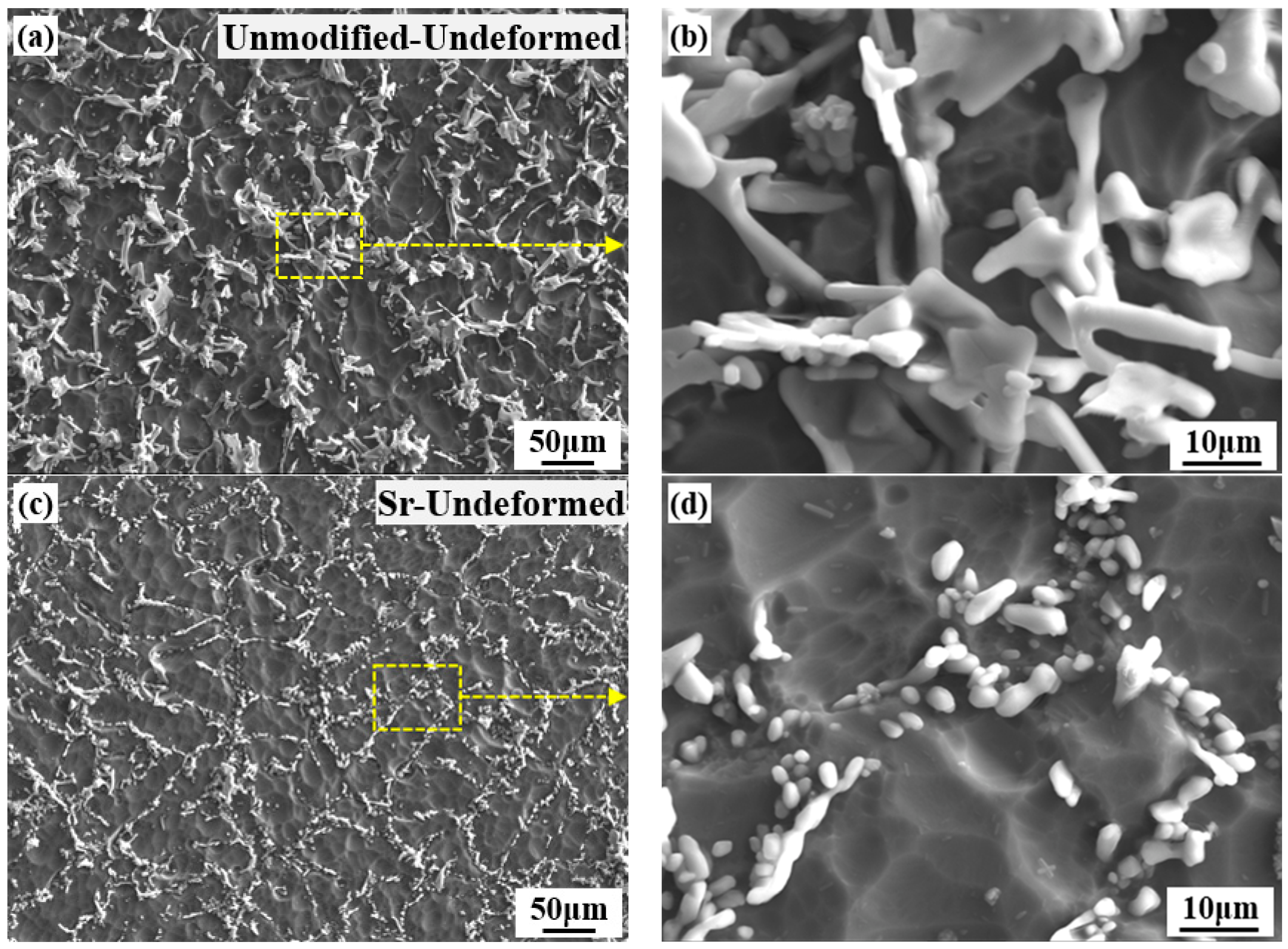
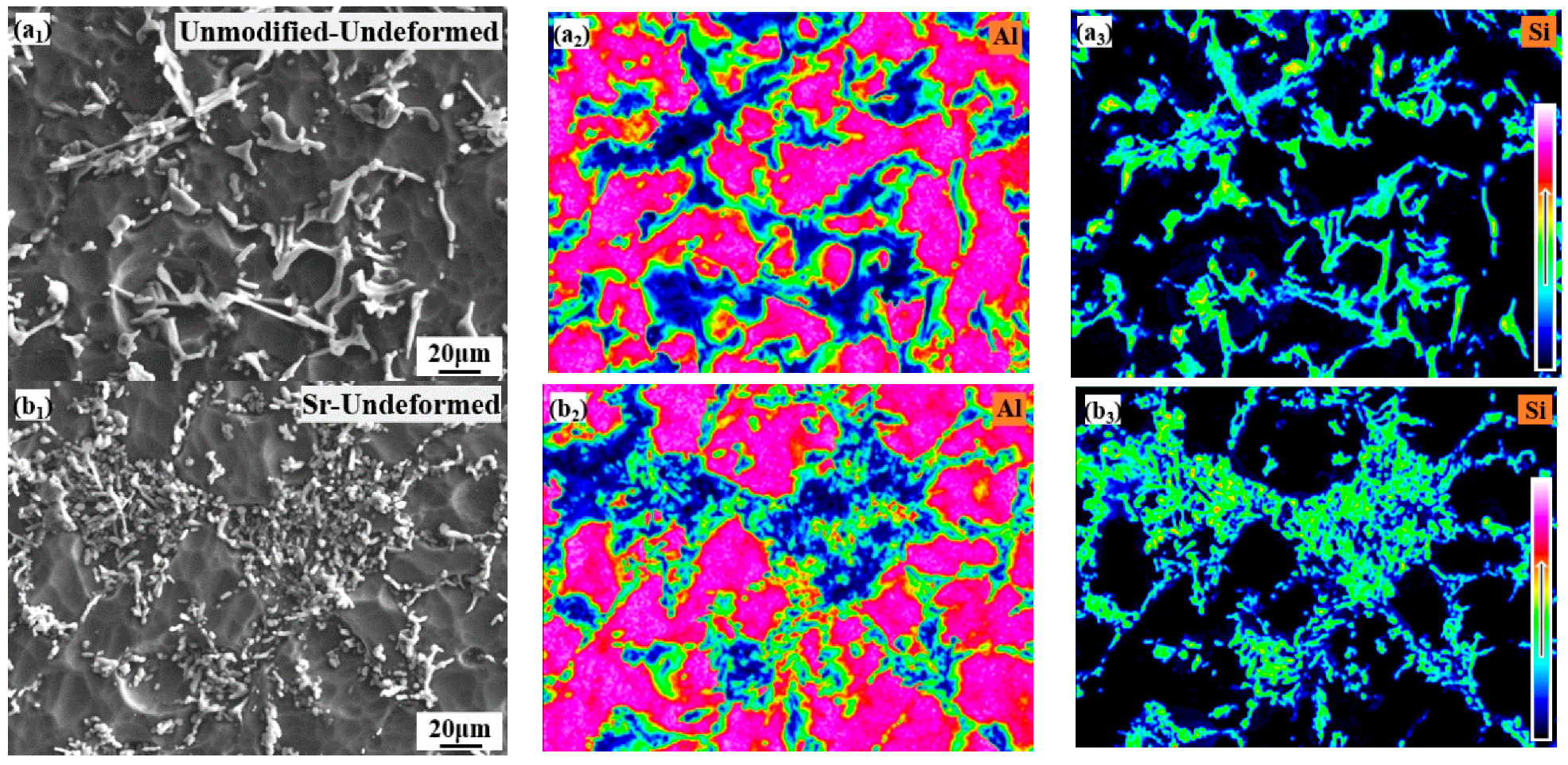
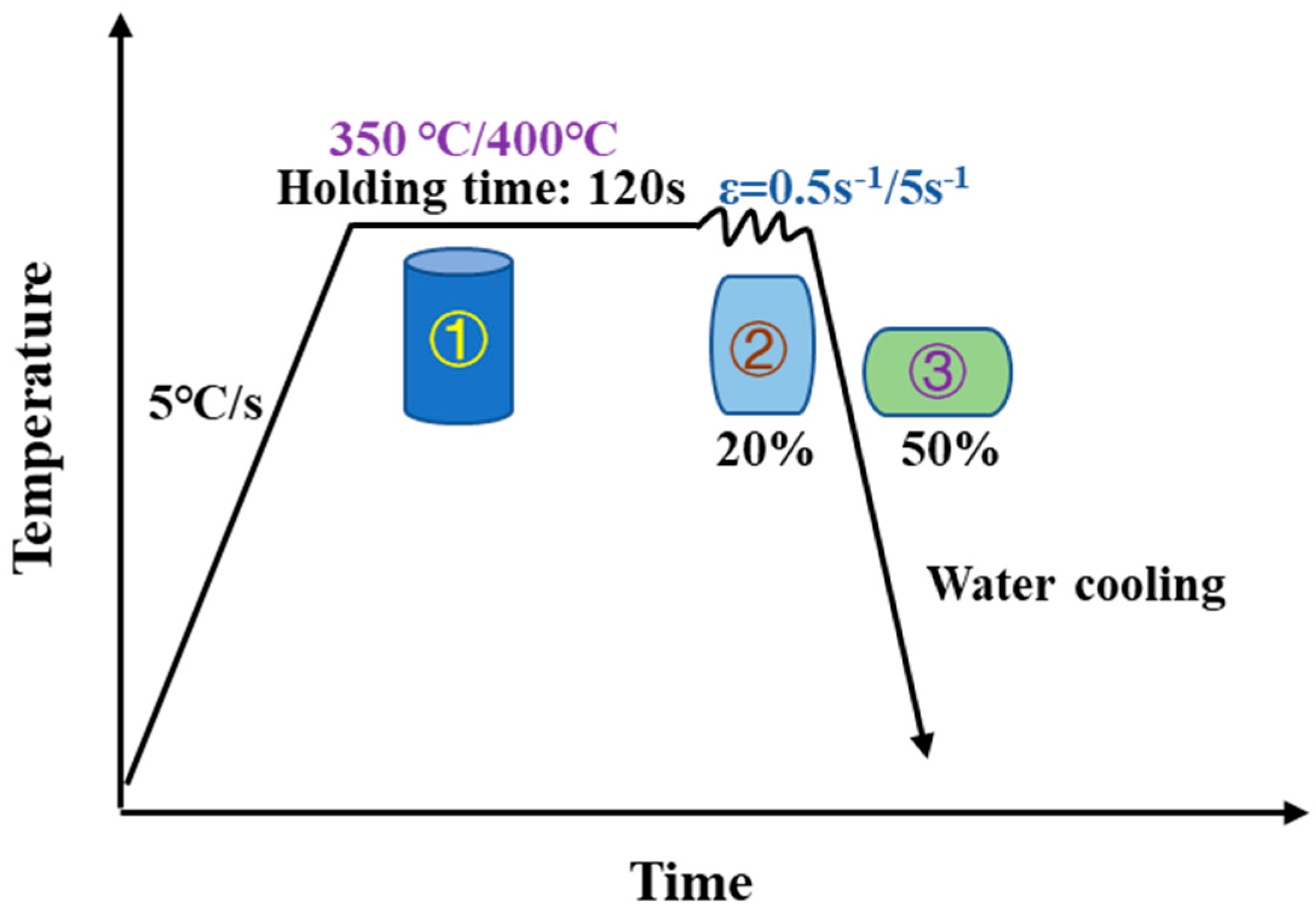
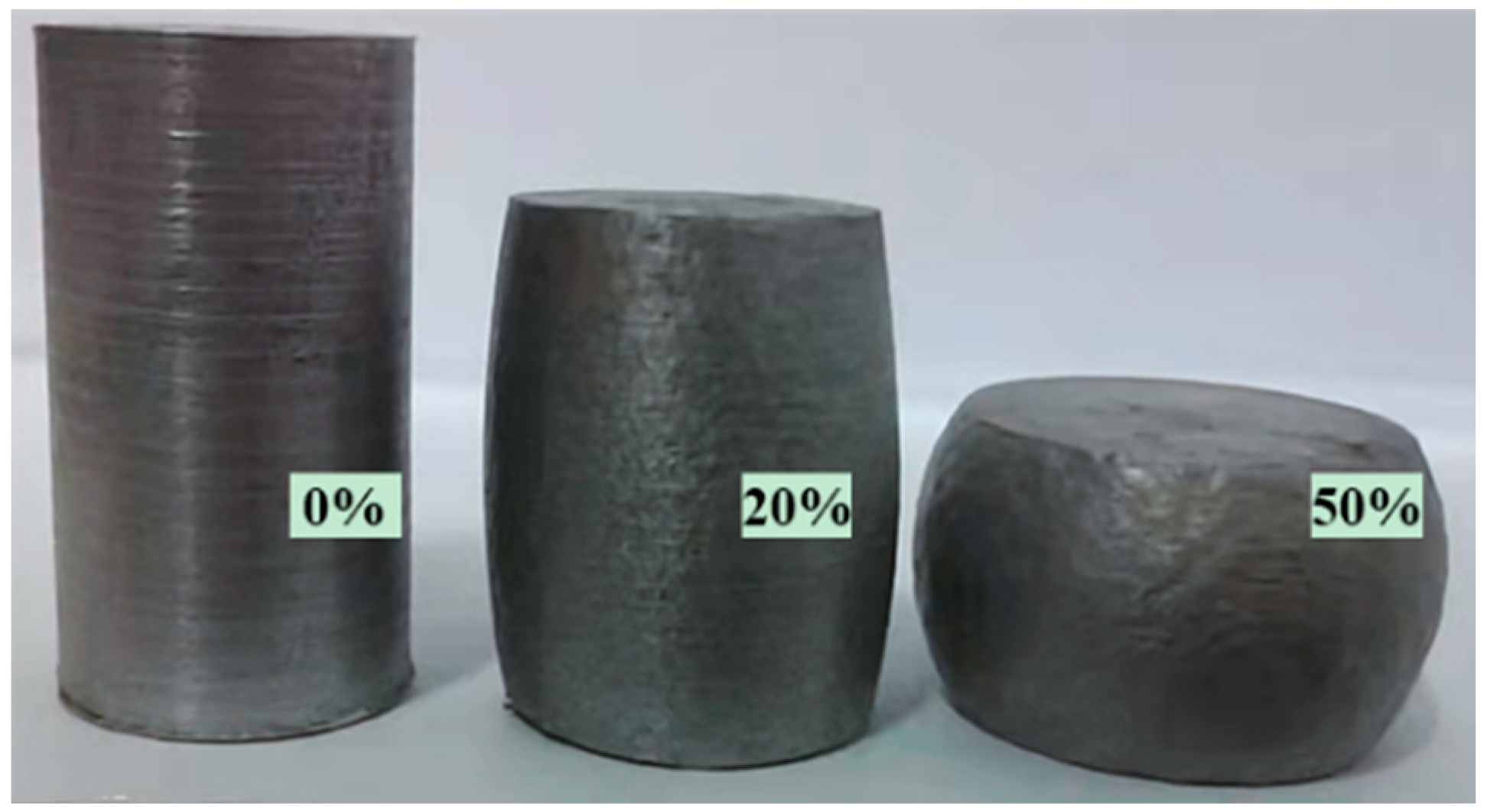
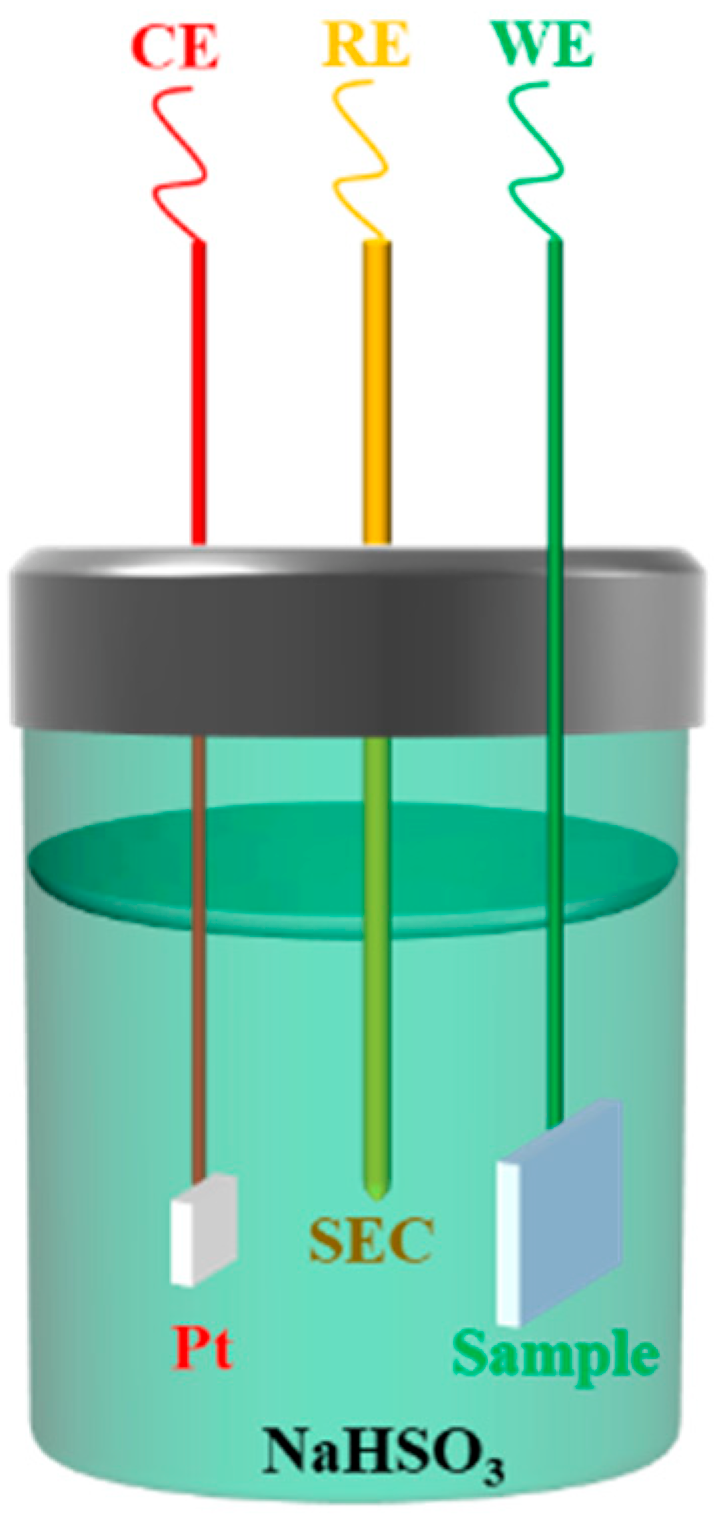
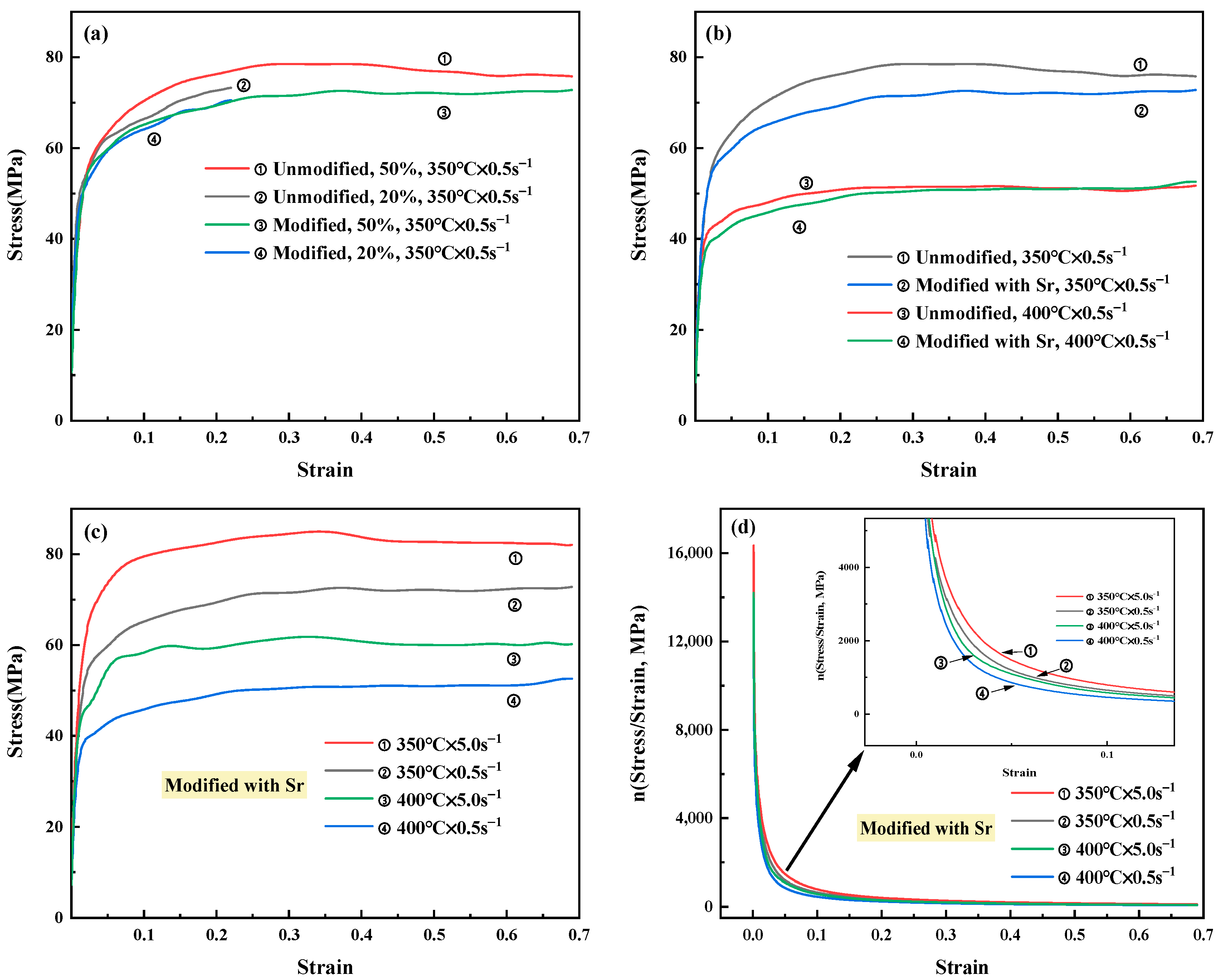
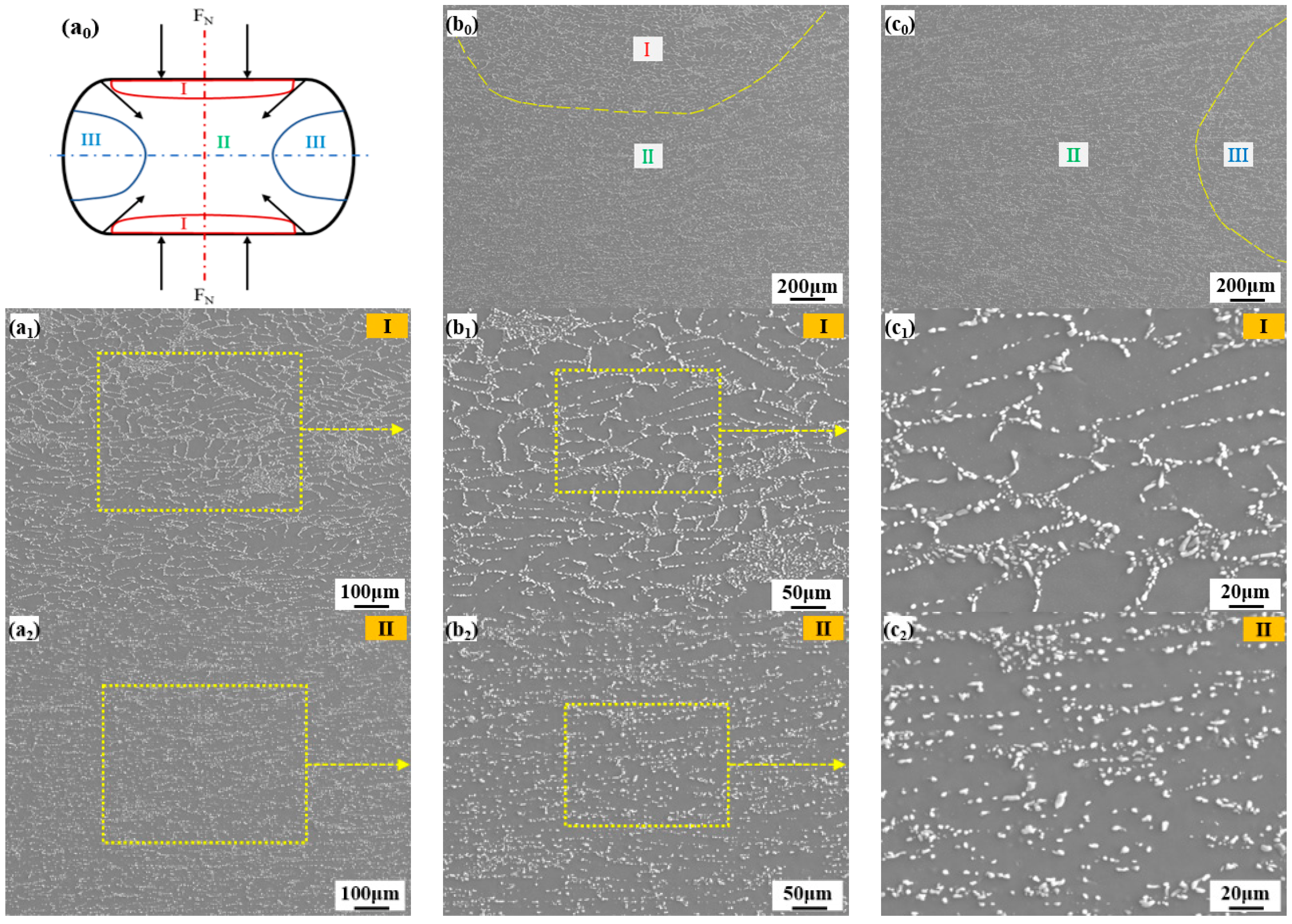

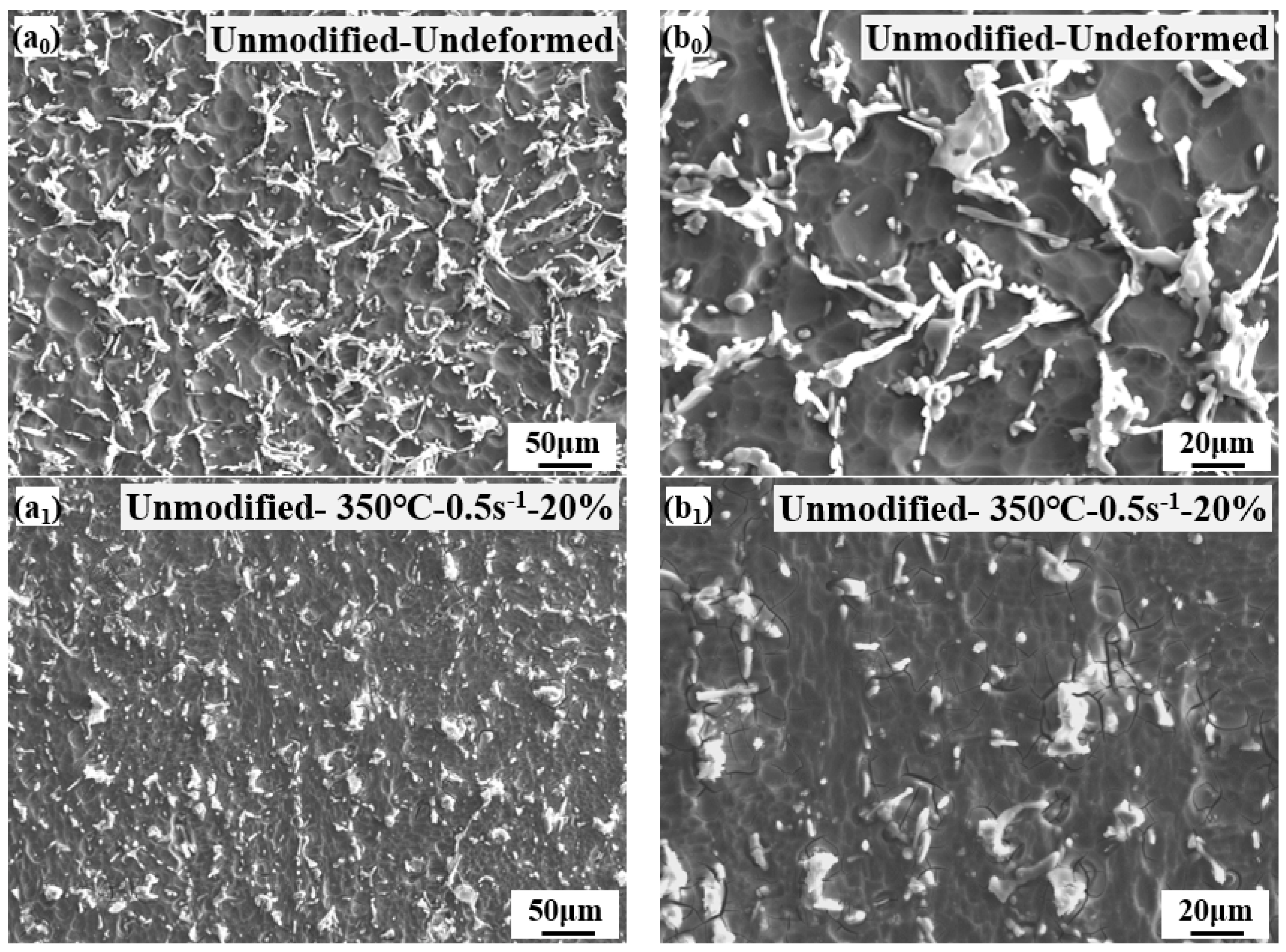
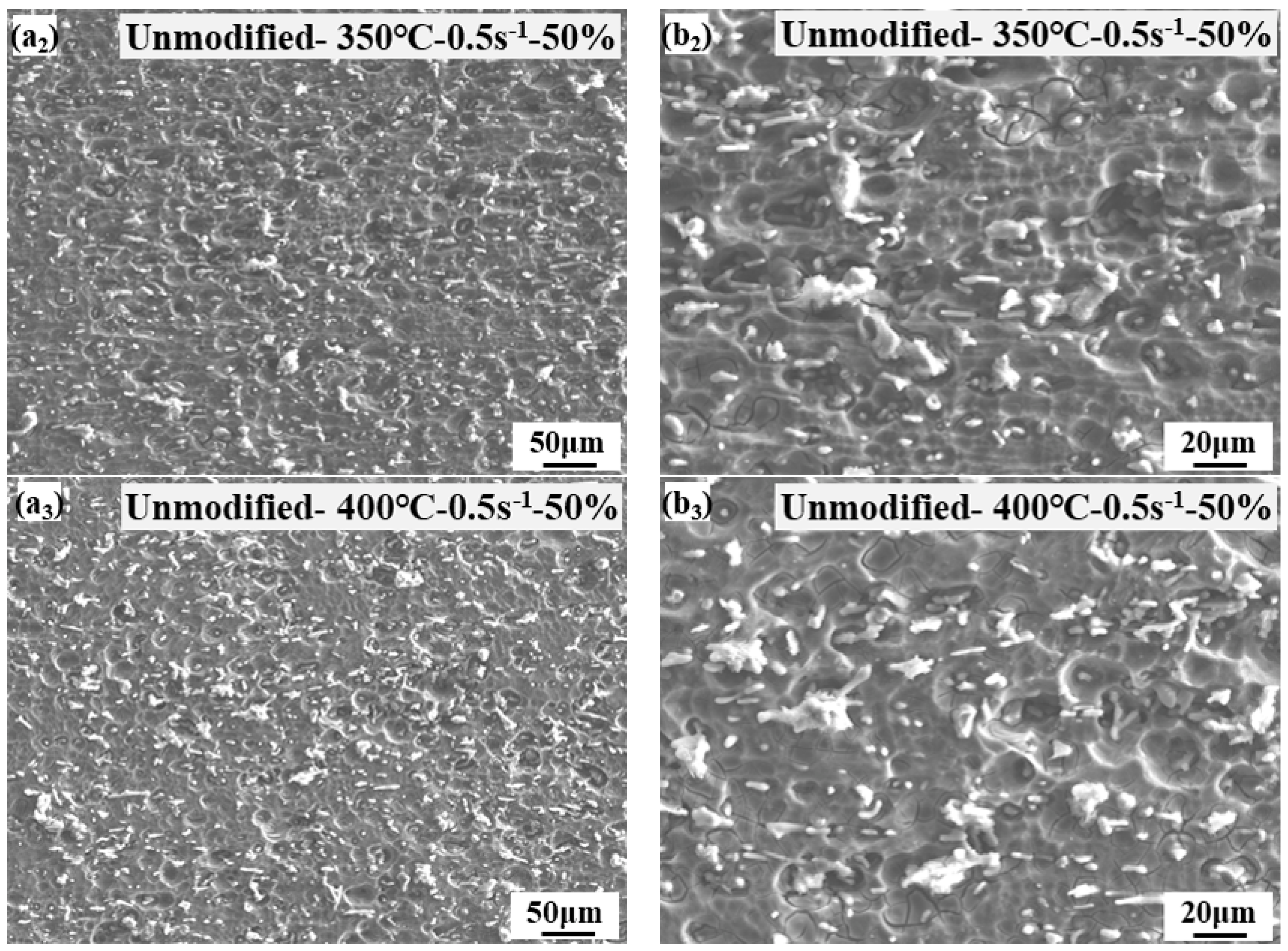
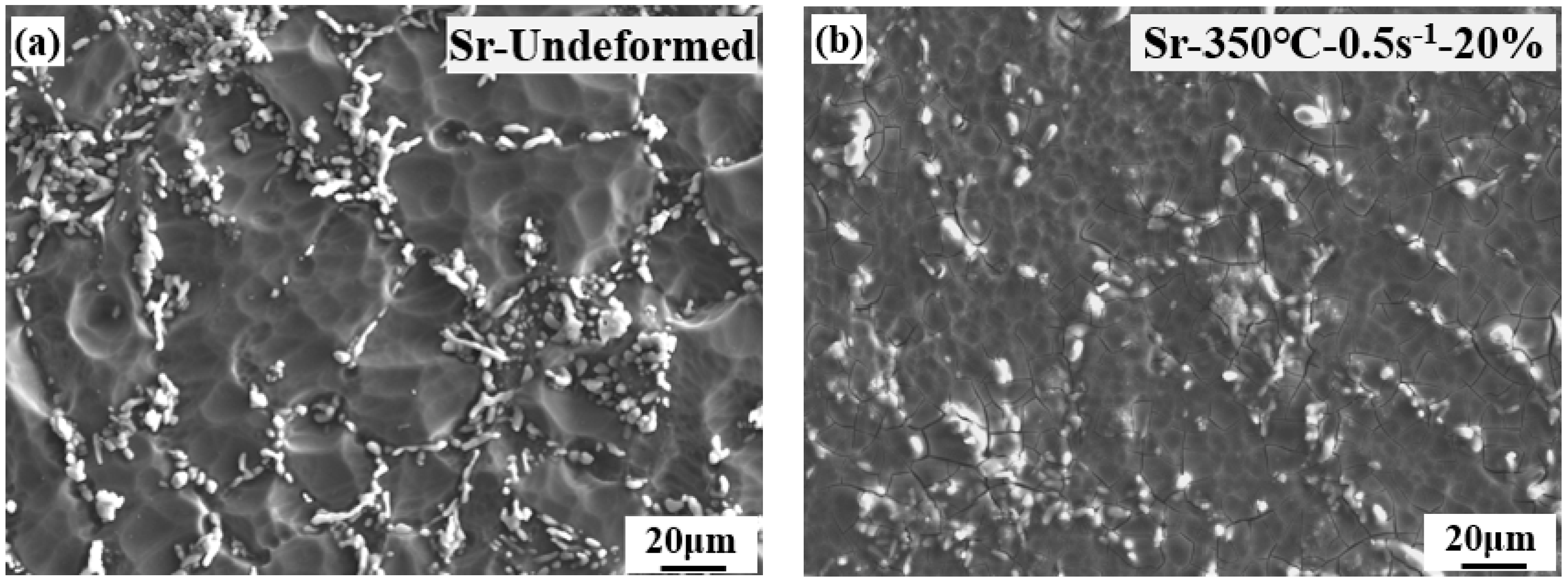


| Element | Si | Mg | Ti | Fe | Sr | Al |
|---|---|---|---|---|---|---|
| unmodified-Al-7Si alloy | 7.22 | 0.32 | 0.20 | 0.111 | - | Bal. |
| Sr-modified-Al-7Si alloy | 7.24 | 0.31 | 0.19 | 0.110 | 0.3 | Bal. |
| Samples | Icorr (μA/cm2) | Ecorr (V vs. SCE) | Corrosion Rate (mm/a) |
|---|---|---|---|
| Unmodified | 4.4537 | -0.54101 | 0.05205 |
| Sr-modified | 1.7012 | -0.51621 | 0.01988 |
Publisher’s Note: MDPI stays neutral with regard to jurisdictional claims in published maps and institutional affiliations. |
© 2022 by the authors. Licensee MDPI, Basel, Switzerland. This article is an open access article distributed under the terms and conditions of the Creative Commons Attribution (CC BY) license (https://creativecommons.org/licenses/by/4.0/).
Share and Cite
Du, K.; Song, L.; Huang, S.; Yuan, X. Influence of Modification on Flow Stress Behavior and Corrosive Properties of a Hypoeutectic Al-Si Alloy. Materials 2022, 15, 2697. https://doi.org/10.3390/ma15072697
Du K, Song L, Huang S, Yuan X. Influence of Modification on Flow Stress Behavior and Corrosive Properties of a Hypoeutectic Al-Si Alloy. Materials. 2022; 15(7):2697. https://doi.org/10.3390/ma15072697
Chicago/Turabian StyleDu, Kai, Liying Song, Shaohui Huang, and Xiaoguang Yuan. 2022. "Influence of Modification on Flow Stress Behavior and Corrosive Properties of a Hypoeutectic Al-Si Alloy" Materials 15, no. 7: 2697. https://doi.org/10.3390/ma15072697





